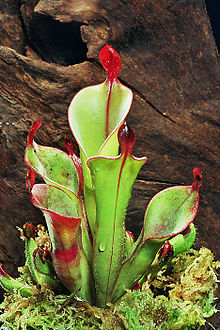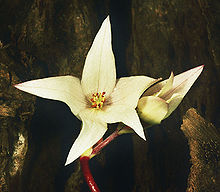Heliamphora
| Heliamphora | |
|---|---|

| |
| Heliamphora chimantensis | |
| Scientific classification | |
| Kingdom: | Plantae |
| Clade: | Tracheophytes |
| Clade: | Angiosperms |
| Clade: | Eudicots |
| Clade: | Asterids |
| Order: | Ericales |
| Family: | Sarraceniaceae |
| Genus: | Heliamphora Benth. (1840) |

| |
| Heliamphora distribution | |
The genus Heliamphora (
Morphology
All Heliamphora species are


Carnivory
Though often counted among the various
Distribution
All Heliamphora species are
Botanical history

The first species of the genus to be described was H. nutans, which
Care in cultivation
Heliamphora are regarded by carnivorous plant enthusiasts and experts as one of the more difficult plants to maintain in cultivation. The genus requires cool (the "highland" species) to warm (the "lowland" species) temperatures with a constant and very high humidity.[10] An amateur botanist in New York City has shown that cultivation of the genus can be achieved with an inexpensive setup consisting of a large plastic crate, a fan, egg cartons, and water bottles filled with ice.[11] The highland species, which originate from high on the humid tepui mountaintops, include H. nutans, H. ionasi, and H. tatei. The lowland Heliamphora, such as H. ciliata and H. heterodoxa have migrated to the warmer grasslands at the foot of the tepuis.
Shredded, long-fibered, or live
Propagation through division only has a limited rate of success, as many plants that are divided go into shock and eventually die. Germination of Heliamphora seed is achieved by scattering it on milled sphagnum moss and keeping in bright light and humid conditions. Seed germination begins after many weeks.
Classification
The genus Heliamphora contains the most species in the Sarraceniaceae family and is joined by the cobra lily (Darlingtonia californica) and the North American pitcher plants (Sarracenia spp.) in that taxon.
Species
Twenty-four species of Heliamphora are currently recognized.[1] Unless otherwise stated, all information and taxonomic determinations in the table below are sourced from the 2011 work Sarraceniaceae of South America authored by Stewart McPherson, Andreas Wistuba, Andreas Fleischmann, and Joachim Nerz.[1] Authorities are presented in the form of a standard author citation, using abbreviations specified by the IPNI.[12] Years given denote the year of the species's formal publication under the current name, not the earlier basionym date of publication if one exists.
Incompletely diagnosed taxa
A further two incompletely diagnosed taxa are known that may represent distinct species in their own right.[1]
| Species | Distribution | Altitudinal distribution |
|---|---|---|
| Heliamphora sp. 'Akopán Tepui' | Venezuela | 1800–1900 m |
| Heliamphora sp. 'Angasima Tepui' | Venezuela | 2200–2250 m |
Varieties
Two
Cultivars
There are currently four registered Heliamphora cultivars including Heliamphora 'Cyclops' (A. Smith), Heliamphora 'Patasola' (B. Tincher & J. Lei), Heliamphora 'Red Mambo' (F. Boulianne), and Heliamphora 'Scylla' (I. Bogdanow).[28][29]
Natural hybrids
At least eleven
- H. arenicola × H. ionasi
- H. ceracea × H. hispida
- H. chimantensis × H. pulchella
- H. elongata × H. ionasi
- H. exappendiculata × H. huberi
- H. exappendiculata × H. pulchella
- H. glabra × H. nutans
- H. huberi × H. pulchella
- H. neblinae × H. parva
- H. purpurascens × H. sarracenioides
- H. sp. 'Akopán Tepui' × H. pulchella
Additionally, putative complex hybrids occur on the
Phylogeny and Diversification
Closely related species tend to be geographically closely distributed. Major Heliamphora clades probably emerged through both geographical separation and dispersal in the Guiana Highlands during Miocene with more recent diversification driven by vertical displacement during the Pleistocene glacial-interglacial thermal oscillations.[31]

References
- ^ a b c d e f g h i j k l m n McPherson, S., A. Wistuba, A. Fleischmann & J. Nerz 2011. Sarraceniaceae of South America. Redfern Natural History Productions, Poole.
- ^ Mellichamp, T.L. 1979. "The Correct Common Name for Heliamphora" (PDF). (196 KB) Carnivorous Plant Newsletter 8(3): 89.
- ISSN 1055-7903.
- ^ S Liu, SD Smith. "Replicated radiations in the South American marsh pitcher plants (Heliamphora) lead to convergent carnivorous trap morphologies". American Journal of Botany. 110 (10): e16230 – via Wiley.
- ^ S2CID 221844433.
- ^ Macfarlane, J.M. 1908. Sarraceniaceae. In: A. Engler Das Pflanzenreich IV, 110, Heft 36: 1–91.
- ISBN 0-88192-356-7Carnivorous Plants of the World a. Pietropaolo p. 72
- ^ a b c Jaffe, K., Michelangeli, F., Gonzalez, J.M., Miras, B., and Ruiz, M.C. (1992). Carnivory in Pitcher Plants of the Genus Heliamphora (Sarraceniaceae). New Phytologist, 122(4): 733-744. (First page available online: JSTOR PDF of first page and HTML text of abstract
- ^ Information on dates and authors of descriptions
- ISBN 0-88192-807-0
- .
- ^ Author Query. International Plant Names Index.
- ^ Wistuba, A., T. Carow & P. Harbarth 2002. Heliamphora chimantensis, a new species of Heliamphora (Sarraceniaceae) from the ‘Macizo de Chimanta’ in the south of Venezuela. Carnivorous Plant Newsletter 31(3): 78–82.
- ^
- ^ Nerz, J. 2004. Heliamphora elongata (Sarraceniaceae), a new species from Ilu-Tepui. Carnivorous Plant Newsletter 33(4): 111–116.
- ^ Nerz, J. & A. Wistuba 2006. Heliamphora exappendiculata, a clearly distinct species with unique characteristics. Carnivorous Plant Newsletter 35(2): 43–51.
- ^ Wistuba, A., P. Harbarth & T. Carow 2001. Heliamphora folliculata, a new species of Heliamphora (Sarraceniaceae) from the ‘Los Testigos’ table mountains in the south of Venezuela. Carnivorous Plant Newsletter 30(4): 120–125.
- ^ (in German) Nerz, J., A. Wistuba & G. Hoogenstrijd 2006. Heliamphora glabra (Sarraceniaceae), eine eindrucksvolle Heliamphora Art aus dem westlichen Teil des Guayana Schildes. Das Taublatt 54: 58–70.
- ^ Steyermark, J. 1951. Sarraceniaceae. Fieldiana, Botany 28: 239–242.
- ^ Nerz, J. & A. Wistuba 2000. Heliamphora hispida (Sarraceniaceae), a new species from Cerro Neblina, Brazil-Venezuela. Carnivorous Plant Newsletter 29(2): 37–41.
- ^ a b Maguire, B. 1978. Sarraceniaceae (Heliamphora). The Botany of the Guyana Highland Part–X, Memoirs of the New York Botanical Garden 29: 36–61.
- ^ a b Gleason, H.A. 1931. Botanical results of the Tyler-Duida Expedition. Bulletin of the Torrey Botanical Club 58(6): 367–368.
- ^ Gleason, H.A. & E.P. Killip 1939. The flora of Mount Auyan-Tepui, Venezuela. Brittonia 3: 141–204.
- ^ Bentham, G. 1840. Heliamphora nutans. The Transactions of the Linnean Society of London 18: 429–432.
- ^ (in German) Wistuba, A., T. Carow, P. Harbarth, & J. Nerz 2005. "Heliamphora pulchella, eine neue mit Heliamphora minor (Sarraceniaceae) verwandte Art aus der Chimanta Region in Venezuela" (PDF). Archived from the original (PDF) on 2011-07-20. Das Taublatt 53(3): 42–50.
- ^ Carow, T., A. Wistuba & P. Harbarth 2005. Heliamphora sarracenioides, a new species of Heliamphora (Sarraceniaceae) from Venezuela. Carnivorous Plant Newsletter 34(1): 4–6.
- ^ (in Spanish) Fleischmann, A. & J.R. Grande Allende 2012 ['2011']. Taxonomía de Heliamphora minor Gleason (Sarraceniaceae) del Auyán-tepui, incluyendo una nueva variedad. [Taxonomy of Heliamphora minor Gleason (Sarraceniaceae) from Auyán-tepui, including a new variety.] Acta Botánica Venezuelica 34(1): 1–11.
- ^ "Heliamphora 'Red Mambo'".
- ^ "Registered Heliamphora cultivars".
- ^ Rivadavia, F. (2008). Cerro Duida, Cerro Avispa, Cerro Aracamuni Archived 2014-04-14 at archive.today. CPUK Forum, 14 June 2008.
- S2CID 221844433– via Elsevier Science Direct.
Further reading
- Barnes, B. 2010. Growing Heliamphora indoors year-round. Carnivorous Plant Newsletter 39(1): 26–27.
- Baumgartl, W. 1993. The genus Heliamphora. Carnivorous Plant Newsletter 22(4): 86–92.
- Brittnacher, J. 2013. Phylogeny and biogeography of the Sarraceniaceae. Carnivorous Plant Newsletter 42(3): 99–106.
- Bütschi, L. [translation by D. Huber & K. Ammann] 1989. Carnivorous plants of Auyantepui in Venezuela. Part 2. Carnivorous Plant Newsletter 18(2): 47–51.
- Clemmens, N.J. 2010. Heliamphora cultivation. Carniflora News1(3): 12–13.
- Dodd, C. & C. Powell 1988. A practical method for cultivation of Heliamphora spp.. Carnivorous Plant Newsletter 17(2): 48–50.
- McPherson, S. 2007. Pitcher Plants of the Americas. The McDonald & Woodward Publishing Company, Blacksburg, Virginia.
- Rivadavia, F. 1999. Neblina expedition. Carnivorous Plant Newsletter 28(4): 122–124.
- Schnell, D. 1974. More about the sunshine pitchers. Garden Journal 24(5): 146–147.
- Schnell, D. 1995. Pollination of heliamphoras. Carnivorous Plant Newsletter 24(1): 23–24.
- Schnell, D. 1995. Heliamphora: the nature of its nurture. Carnivorous Plant Newsletter 24(2): 40–42.
- Tincher, B. 2013. My techniques for the indoor cultivation of Heliamphora. Carnivorous Plant Newsletter 42(4): 137–144.
- Wistuba, A. 1990. Growing Heliamphora from the Venezuelan tepui. Carnivorous Plant Newsletter 19(1–2): 44–45.
- Ziemer, R.R. 1979. Some personal observations on cultivating the Heliamphora. Carnivorous Plant Newsletter 8(3): 90–92.
External links
- Growing and propagating Heliamphora from the International Carnivorous Plant Society
- Heliamphora FAQs from Barry Rice's Carnivorous Plant FAQ








